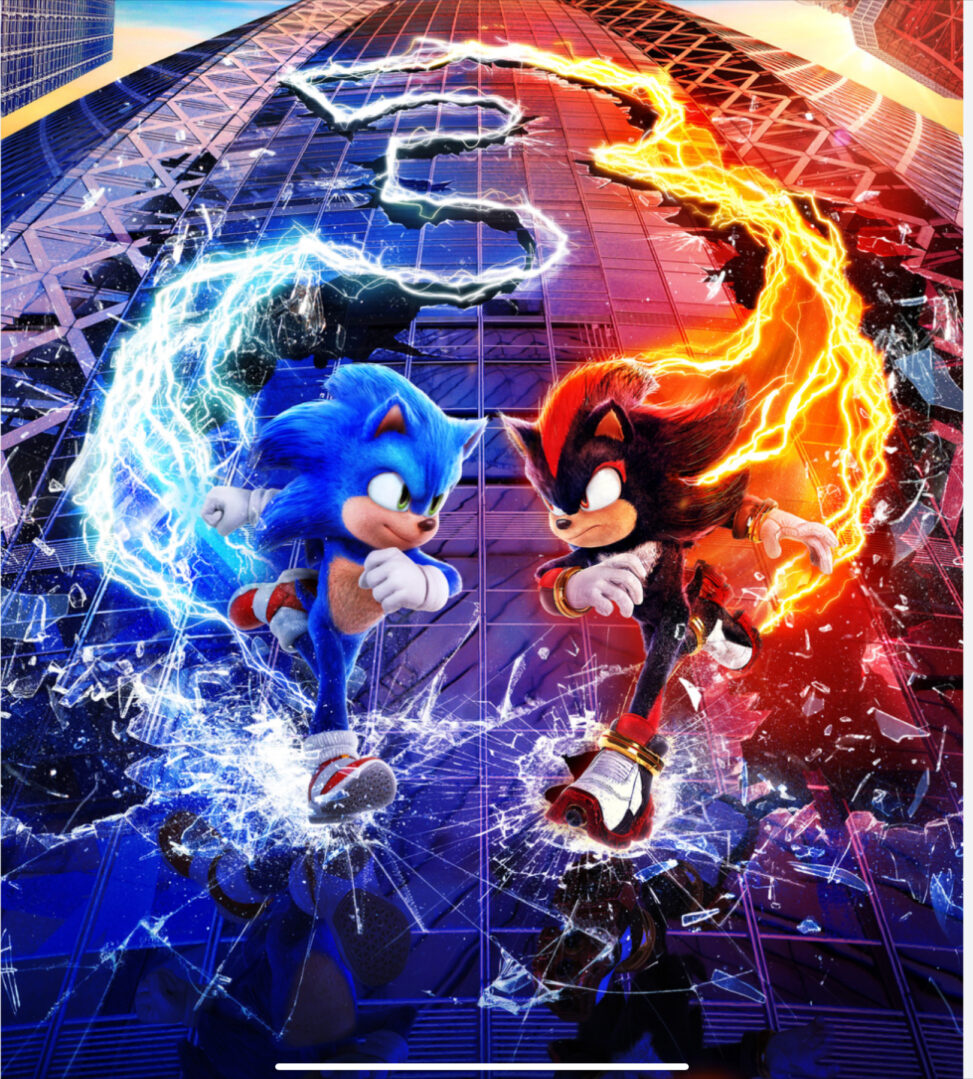In this action scene, Sonic is shown racing through a futuristic cityscape as Dr. Robotnik’s mechanical goons chase him. The futuristic, high-energy setting is emphasized by the mise en scene, which has metallic structures, neon lights, and expansive city streets. A sense of urgency is created by the dramatic lighting, which includes dazzling explosion flashes and Sonic’s blue streak glow.
The fast-paced movement and wild sights characterize this action sequence. Several quick cuts that express speed are used in the editing, frequently switching from Sonic’s point of view to broad vistas that highlight the extent of the devastation left in his wake. I found about ten to twelve short edits in a one-minute period that highlight various viewpoints, including broad shots of the chase, close-ups of Sonic’s face.
With explosions and tense near-miss situations, the violence moves quickly. The main character is Sonic, a male anthropomorphic blue hedgehog, while the adversary is Dr. Robotnik, who is also male. The physical prowess of the characters—Robotnik’s technological prowess vs Sonic’s speed—is strongly highlighted. The action primarily involves masculine characters, creating a clear gender contrast. Although Sonic’s speed is essential to the physics of the action, there isn’t much emphasis on race or skill in this scene.
In Men, Women, and Chainsaws, Clover (1992) describes how the action genre frequently uses violence to advance the plot, with the protagonist usually fighting in ways that demonstrate their power or speed.
In The Sixties, Gitlin (2015) discusses how the tempo of contemporary action movies, like those in the Sonic franchise, mirrors the growing speed of modern life and technology. Action scenes in these movies reflect the “always-on” aspect of modern culture.
According to Modleski (1982) in The Women Who Knew Too Much, female characters are frequently reduced to supporting parts or romantic interests in action movies, which frequently centre on male heroes (like Sonic) who must save the day. Sonic the Hedgehog is another example of this cliché.
According to Lau (2014) in The Routledge Companion to Film and Gender, males are portrayed as heroes and strong men in modern action movies, which can occasionally result in problematic representations of masculinity and the upholding of traditional gender norms.
As discussed by Bordwell and Thompson (2008) in Film Art: An Introduction, the Sonic franchise exemplifies the use of editing techniques such as quick cuts in action movies to generate a heightened sense of pace and urgency. The impression of speed and chaos is increased by the quick edits, which compress time and space.
Sonic the Hedgehog 3 did well at the box office upon its release, earning more over $400 million worldwide. Thanks to a large fan base, the ongoing appeal of video game adaptations, and impressive global success, this was an increase above its predecessors.
Movies like Sonic the Hedgehog 3 may affect audiences in both positive and bad ways due to their fast-paced action, frequent violence, and powerful scenes. Positively, they offer enjoyment and escape to a wide range of people. Even while the film’s depiction of violence isn’t overtly explicit, it could cause viewers, especially younger ones, to become desensitized. It’s crucial to think about how frequent exposure to fast-paced, action-packed stories may affect how people view speed, masculinity, and conflict resolution. Furthermore, quick editing can encourage a tendency for consuming media quickly, which could reduce attention spans.
Gulo, Joseph Anderson, and Arsen Nahum Pasaribu. 2023. “Expressive Speech Acts Analysis of ‘Sonic the Hedgehog 2’ Movie.” IDEAS: Journal on English Language Teaching & Learning, Linguistics & Literature 11 (1): 365–76. doi:10.24256/ideas.v11i1.3694.
Cooper, Rory L, and Michel C Milankovitch. 2025. “In Vivo Sonic Hedgehog Pathway Antagonism Temporarily Results in Ancestral Proto-Feather-like Structures in the Chicken.” PLoS Biology 23 (3): e3003061. doi: 10.1371/journal.pbio.3003061.
Cai, Maoping, Shengdong Ge, Yaying Hong, Yao Chen, Yang-Zi Ren, Dacai Zhong, Mingkun Chen, et al. 2025. “Tegaserod Maleate Exerts Anti-Tumor Effects on Prostate Cancer via Repressing Sonic Hedgehog Signaling Pathway.” Molecular Medicine (Cambridge, Mass.)31 (1): 30. doi:10.1186/s10020-025-01080-1.
Ghorbanlou, Mehrdad, Hasan Marzban, and Mehdi Mehdizadeh. 2023. “Targeting Positive Regulators of Sonic Hedgehog Signaling Pathway in Medulloblastoma by Designing CRISPR/Cas9 Single Guide RNAs.” Journal of Advances in Medical & Biomedical Research 31 (149): 594–601. doi:10.30699/jambs.31.149.594.
Ducatel, Arnaud, Hervé Trillaud, Edouard Reizine, Valérie Vilgrain, Christine Sempoux, Sabine Schmidt-Kobe, Annette S H Gouw, et al. 2024. “Sonic Hedgehog Hepatocellular Adenoma: Magnetic Resonance Imaging Features and Correlation with Histology.” European Radiology 34 (7): 4649–62. doi:10.1007/s00330-023-10344-5


Great Amanze
Jacinta analysis of the action scene from Sonic the Hedgehog 3 provides a comprehensive breakdown of its cinematic elements, including mise-en-scène, editing techniques, and character dynamics. The description effectively captures the film’s high-energy sequences, highlighting the use of metallic structures, neon lights, and expansive cityscapes to create a futuristic atmosphere. The observation of rapid editing, with approximately ten to twelve cuts per minute, aligns with the genre’s conventions to convey speed and urgency.
Jacinta’s integration of scholarly sources to contextualize these observations could be more precise. For instance, while Carol Clover’s Men, Women, and Chainsaws (1992) examines violence in horror films, its direct application to the action sequences in Sonic the Hedgehog 3 is limited. Similarly, Todd Gitlin’s The Sixties (2015) discusses the cultural shifts of that era but may not directly correlate with the pacing of contemporary action films. A more pertinent source might be David Bordwell and Kristin Thompson’s Film Art: An Introduction (2008), which delves into editing techniques and could provide a theoretical framework for analyzing the film’s rapid cuts.
Regarding the portrayal of gender, the analysis notes the predominance of male characters, with Sonic and Dr. Robotnik at the forefront. However, it’s important to recognize that the Sonic franchise, rooted in its video game origins, has a longstanding focus on these central characters, which may influence their prominence in the film adaptations. However, a more careful selection and application of scholarly sources would enhance the depth and accuracy of the critique.